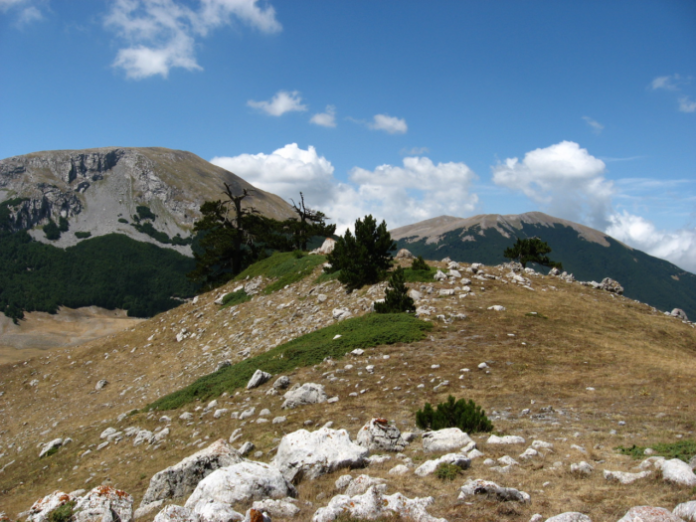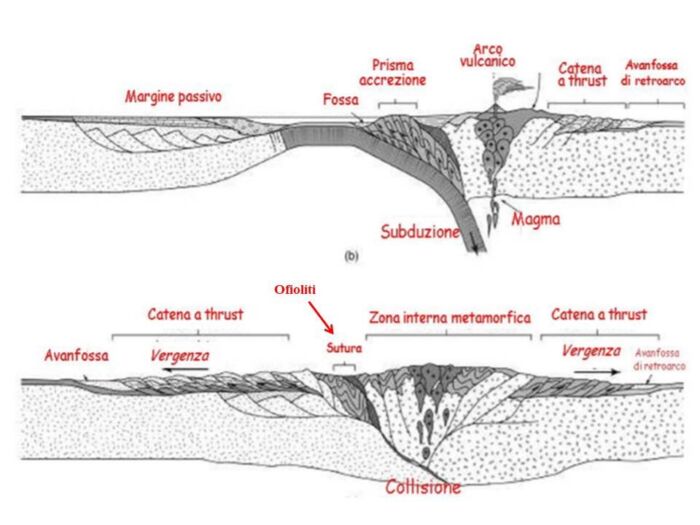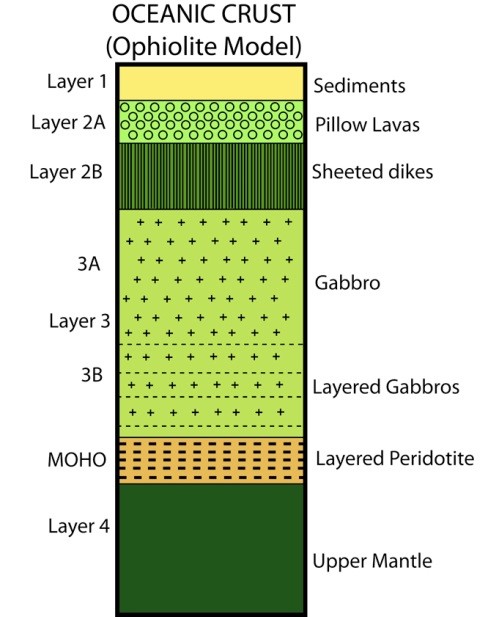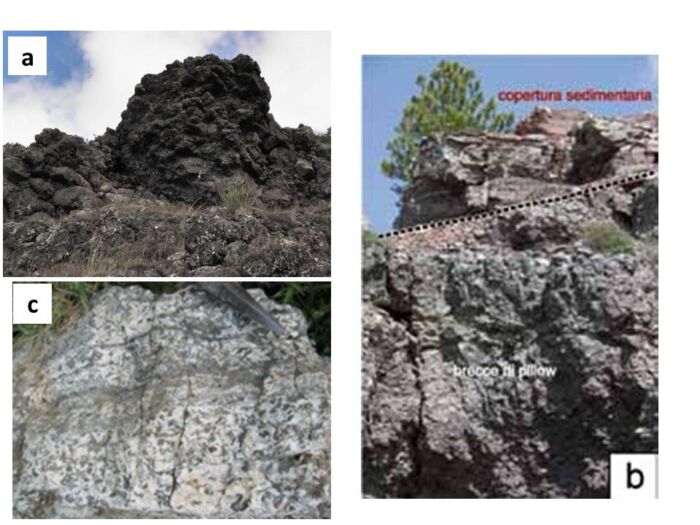
The calabro-lucanian boundary area geologically represents a key zone for understanding the orogenetic processes in this Apenninic sector and, at a bigger scale, the Mediterranean geodynamic processes. The Pollino Massif is a National Park from 1993, characterised by 192.565 hectares between Basilicata and Calabria southern Italian regions and it represents the most extended natural park of Italy. Among the several peculiarities in term of landscape, flora and fauna, there are lots of geological features as for the ophiolitic outcrops, mainly located in the northern sector of the massif.
Ophiolites are rock or rock’s suite (from the upper Mantle to the Oceanic Crust until the sedimentary cover) with a mafic and ultra-mafic composition, representing the remains of ancient oceans. This oceanic crust may be included into an orogen, during plates convergence, continental collision and mountain chain formation. In general, converging tectonic plates generate subduction processes, where usually oceanic crust underthrusts beneath a continental lithospheric plate. When subduction ends, because the under-thrusting plate passively drags a continental block, it starts the continental collision, in which some patches of oceanic crust may be teared up and tectonically over thrusted, with the result that they were included into the orogen. The internal area where this process occurs is named oceanic suture (“sutura” in fig. 1). The ophiolitic rocks (corresponding to the oceanic sutures) represent the proofs of existing ancient oceans interposed between two converging tectonic plates, that reached the continental collision phase.

Fig. 1 – Subduction and continental collision schemes, highlighting the suture zone, where ophiolitic rocks outcrop
In the northern sector of the Pollino Massif, extensively outcrop alloctone units of the Ligurides Complex, so named for the correlation with ophiolitic units of the Northern Apennines (Liguria) and representing Cretacic-Paleogenic sequence deposed in the oceanic basin of NeoTethys. These oceanic realms were interposed between European and African Plate during the Jurassic. The subduction of the oceanic crust beneath the Calabrian continental crust (Upper Cretaceous – Oligocene) determines the building of an accretionary prism, which deformed and affected with variable grade of metamorphism the rocks of the sedimentary cover of the NeoTethys, including several remains of the ancient oceanic crust (Ophiolites).
The sedimentary and metamorphic units deformed by the accretionary prism are respectively inlcuded in the Northern Calabrian units and in the Frido Unit, so representing the southernmost extremities of the ophiolitic units of the whole Apennines. During the collisional phases, several thrusts progressively overlapped these units and, in some cases, tectonically removed oceanic lithosphere (fig. 2).

Fig. 2 – Oceanic lithosphere scheme (ophiolitic model).
One of the most spectacular ophiolitic outcrop of the Pollino Ridge is located in Timpa delle Murge (fig. 3 ), where there is a complete lithospheric suite, from the upper Mantle to the ancient sedimentary cover. In details and from the bottom, there are Serpentinites, dark green rocks in little outcrops as representing the deepest portion of the ophiolitic sequence (metamorphosed Upper Mantle); upward there are Gabbros, intrusive magmatic rocks, with plagioclase and diallage (a green colour clinopyroxen, rich in Calcium, Aluminum and Magnesium). The effusive terms are charaterised by pillow lavas (emitted in typical submarine eruptions) and pillow breccias, with variolitic boundaries and with ialoclastic matrix, frequently showing green alteration in Clorite and/or with radiolaritic or calcareous-marly red matrix.
The overlying sedimentary cover (Timpa delle Murge Formation) is made by red siliceous mudstones (25 cm), green and red radiolarites (1.8 m), red and light red marly limestones with intercalations of marls and calcareous marls (90 cm), red and green mudstones with two intercalations of fine quarzoarenites (4 m) and finally grey-brown mudstones and silty mudstones. At the bottom of the sedimentary cover, there are deformational structures as boudinage and clivage, for the very extensive strain caused by tectonic stresses, and also more recent extensional fault systems deforming the whole rock blocks. This complete ophiolitic suite shows a very good preservation state and represent one of the most famous outcrops of the area, visited both for educational goal both for several scientific reseaerches, regarding the petrography, the geochemistry and the geodynamic.

Fig. 3 – Features of the Timpa delle Murge outcrop: a) Pillow lavas, b) Pillow breccias and sedimentary cover, c) gabbros
The northern portion of the Pollino Ridge is characterised by several ophiolitic outcrops, but Timpa delle Murge is the most complete lithospheric sketch of the Liguride Ocean. The geological features of this sector of the Apennines are extensively described in the Regional Geological Guide of the Basilicata region, very recently published (March 2021) and edited by the Italian Geological Society. In this guide are synthesized all the scientific researches of this area until the more recent studies, including descriptions and interpretetions in appropriated itinerary, easy to reach and to trek. In details, this area of the Pollino Massif is well described into the n. 8 itinerary, characterised by 8 stops corresponding to the most representative outcrops, each one enriched by the right geological description.
Along this tour, it’s possible to travel not only in space but also in time, trekking on the remains of an ocean of Jurassic age (at least 150 million of yaers ago), today visible in few areas in Italy, between Apennines and Alps.
For these reasons, Timpa delle Murge is one of the most important geosite of the Pollino National Park and, considering also the whole ophiolitic rocks outcropping in this sector of Apennines, it needs to highlight several studies on environmental themes for such rocks, containing asbestos mineral (Tremolite and Chrysolite) as potential risks during engineering works realization. Indeed, for these areas are provided particular safety rules in case of earthmoving works, to avoid uncontrolled diffusion of these minerals, dangerous for human health.
Hence, Basilicata can be considered one of the richest regions from a geological point of view, representing a real open sky laboratory.



































